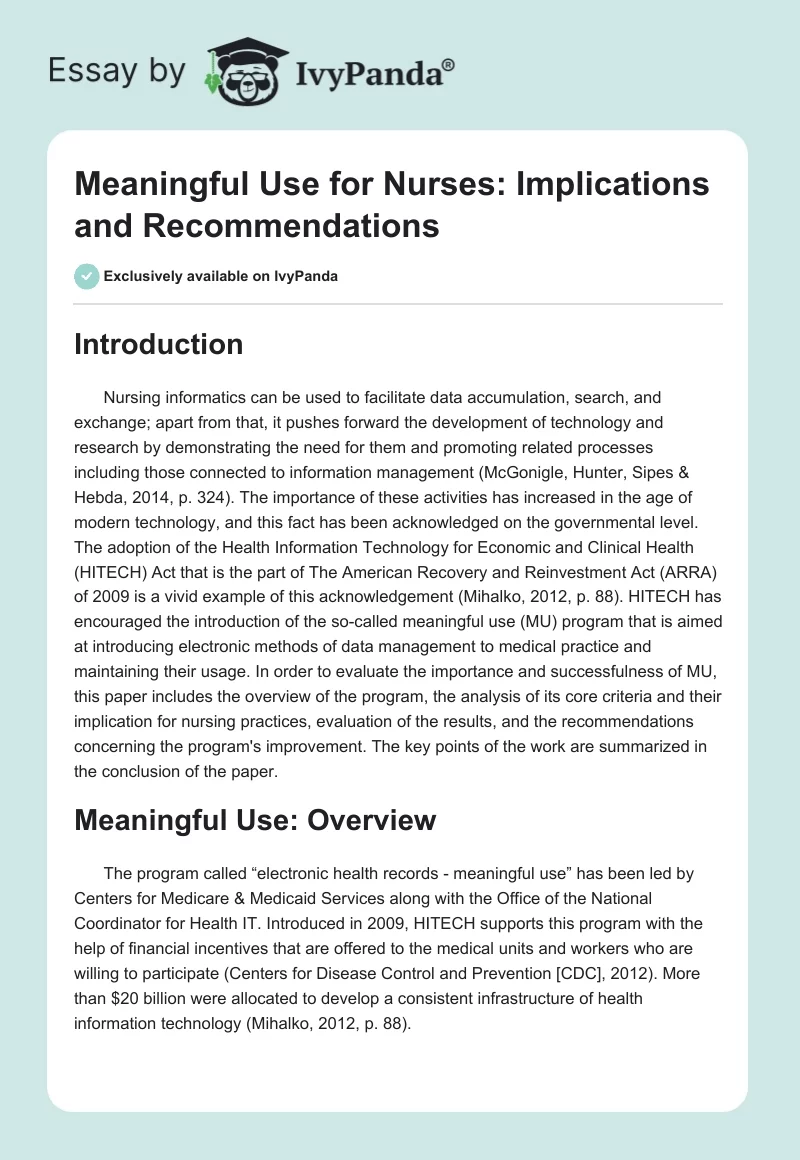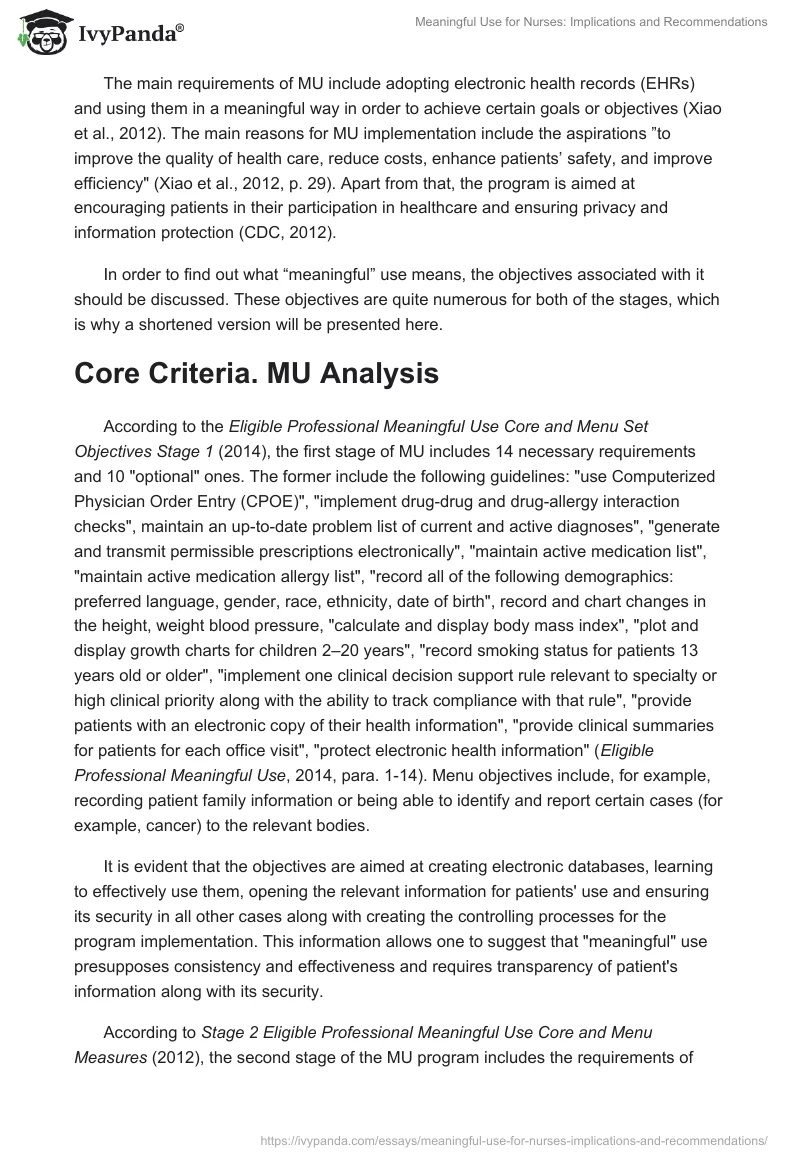Introduction
Nursing informatics can be used to facilitate data accumulation, search, and exchange; apart from that, it pushes forward the development of technology and research by demonstrating the need for them and promoting related processes including those connected to information management (McGonigle, Hunter, Sipes & Hebda, 2014, p. 324). The importance of these activities has increased in the age of modern technology, and this fact has been acknowledged on the governmental level. The adoption of the Health Information Technology for Economic and Clinical Health (HITECH) Act that is the part of The American Recovery and Reinvestment Act (ARRA) of 2009 is a vivid example of this acknowledgement (Mihalko, 2012, p. 88). HITECH has encouraged the introduction of the so-called meaningful use (MU) program that is aimed at introducing electronic methods of data management to medical practice and maintaining their usage. In order to evaluate the importance and successfulness of MU, this paper includes the overview of the program, the analysis of its core criteria and their implication for nursing practices, evaluation of the results, and the recommendations concerning the program’s improvement. The key points of the work are summarized in the conclusion of the paper.
Meaningful Use: Overview
The program called “electronic health records – meaningful use” has been led by Centers for Medicare & Medicaid Services along with the Office of the National Coordinator for Health IT. Introduced in 2009, HITECH supports this program with the help of financial incentives that are offered to the medical units and workers who are willing to participate (Centers for Disease Control and Prevention [CDC], 2012). More than $20 billion were allocated to develop a consistent infrastructure of health information technology (Mihalko, 2012, p. 88).
The main requirements of MU include adopting electronic health records (EHRs) and using them in a meaningful way in order to achieve certain goals or objectives (Xiao et al., 2012). The main reasons for MU implementation include the aspirations ”to improve the quality of health care, reduce costs, enhance patients’ safety, and improve efficiency” (Xiao et al., 2012, p. 29). Apart from that, the program is aimed at encouraging patients in their participation in healthcare and ensuring privacy and information protection (CDC, 2012).
In order to find out what “meaningful” use means, the objectives associated with it should be discussed. These objectives are quite numerous for both of the stages, which is why a shortened version will be presented here.
Core Criteria. MU Analysis
According to the Eligible Professional Meaningful Use Core and Menu Set Objectives Stage 1 (2014), the first stage of MU includes 14 necessary requirements and 10 “optional” ones. The former include the following guidelines: “use Computerized Physician Order Entry (CPOE)”, “implement drug-drug and drug-allergy interaction checks”, maintain an up-to-date problem list of current and active diagnoses”, “generate and transmit permissible prescriptions electronically”, “maintain active medication list”, “maintain active medication allergy list”, “record all of the following demographics: preferred language, gender, race, ethnicity, date of birth”, record and chart changes in the height, weight blood pressure, “calculate and display body mass index”, “plot and display growth charts for children 2–20 years”, “record smoking status for patients 13 years old or older”, “implement one clinical decision support rule relevant to specialty or high clinical priority along with the ability to track compliance with that rule”, “provide patients with an electronic copy of their health information”, “provide clinical summaries for patients for each office visit”, “protect electronic health information” (Eligible Professional Meaningful Use, 2014, para. 1-14). Menu objectives include, for example, recording patient family information or being able to identify and report certain cases (for example, cancer) to the relevant bodies.
It is evident that the objectives are aimed at creating electronic databases, learning to effectively use them, opening the relevant information for patients’ use and ensuring its security in all other cases along with creating the controlling processes for the program implementation. This information allows one to suggest that “meaningful” use presupposes consistency and effectiveness and requires transparency of patient’s information along with its security.
According to Stage 2 Eligible Professional Meaningful Use Core and Menu Measures (2012), the second stage of the MU program includes the requirements of stage 1. However, apart from that some menu objectives (for example, incorporating clinical lab-test into EHR) have been turned into general requirements. As a result, the new stage includes 17 necessary requirements and six menu objectives, for example, recording “family health history as structured data” (Stage 2, 2012, para. 21). One may say that the second stage is mostly aimed at proceeding to implement the program by increasing the number of necessary requirements and encouraging participants to maintain their progress.
The two stages of the MU program suggest a consistent plan of introducing electronic data management into everyday medical practice, maintaining the achieved results and proceeding to use the technologies to optimize relevant processes. The implications of this program for nurses are most important. It has been proved that nurses tend to spend more than one-fourth of their working time on documentation activities. Most certainly as a result of this fact, the efficiency of adopting the MU was also higher when a nurse was responsible for it (Mihalko, 2012, pp. 88-89). Therefore, nurses can benefit from the successful implementation of the program. However, it also means that the complicated process of fulfilling the requirements of MU is in many ways the responsibility of the nurses.
Results Evaluation. Meaningful Use Recommendations
In order to define the recommendations that can be suggested for MU improvement, the successfulness of the program’s implementation process should be evaluated.
It can be pointed out that the receptions of the Act, as well as the evaluations of its implementation and outcomes, are not homogeneous. It is not uncommon to demonstrate that the MU program results in increasing hospital’s costs or that it demands nurses to spend more time on relevant activities (Xiao et al., 2012). One should mention, that these complications may be regarded as the temporary difficulties of the period of adjustment. Apart from that, it has been suggested that the unsuccessful implementation of MU may indicate the flaws in the implementation processes and not the program itself (Xiao et al., 2012, p. 33). In any case, the program proved to be capable of motivating US hospitals and practitioners to adopt EHRs (Botta & Cutler, 2014; Xiao et al., 2012; Mihalko, 2012). Apart from that, scientific studies have shown that the use of EMRs which can be qualified as “meaningful” (in the meaning of the term as described above) tends to improve the quality and efficiency and care indeed (Xiao et al., 2012).
What is more, it is not uncommon for bigger establishments to regard the MU requirements as a minimum objective and intend to develop their usage of EHRs further. Therefore, the program has fulfilled its primary aim as an impetus to further development of electronic data management use within medical institutions. At the same time, in other cases, when adopting the program appeared to be counterproductive, the hospitals that could not afford it, refrained from participating in MU (Botta & Cutler, 2014, p. 48-52). Apart from that, certain difficulties have been singled out as accompanying the process of MU implementation. For example, large systems tend to isolate themselves and fail to share potentially valuable data with similar institutions, while cooperating within their limits (Miller & Tucker, 2014, p. 40). In general, it has been pointed out that the particular needs of different fields of practice and possibly separate facilities could be taken into account (Mihalko, 2012, p. 89). The institutions that cannot afford MU, as well as bigger networks, are the examples of these peculiarities. It appears evident that such elements require specific management. It seems logical that this kind of initiative is not supposed to be “top-down”; instead, practitioners and nurses should be encouraged to customize the MU processes and, possibly, suggest changes that could be useful on a larger scale. This way, the general guidelines provided by the MU program can be improved with regard to the actual problems that hinder its implementation on different levels.
Conclusion
MU is a governmentally sponsored program aimed at creating an infrastructure of electronic data management technologies for medical use within the US. The essential features required of MU participants include consistency and effectiveness; the information must be transparent and secure. Nurses are involved in the process of the program implementation since it is them who is usually responsible for the relevant information. For the time being, the results of MU implementation vary as the participants encounter various problems that differ between fields of practice and separate facilities. In order to optimize the program’s implementation, customized versions of MU for selected areas could be offered. While the work that nurses spend on relevant procedures is expected to increase during the adoption period, eventually the process is most likely to become optimized.
References
Botta, M., & Cutler, D. (2014). Meaningful use: Floor or ceiling? Healthcare, 2(1), 48-52. Web.
Centers for Disease Control and Prevention. (2012). Meaningful Use. Web.
Eligible Professional Meaningful Use Core and Menu Set Objectives Stage 1.(2014). Web.
McGonigle, D., Hunter, K., Sipes, C., & Hebda, T. (2014). Why Nurses Need to Understand Nursing Informatics. Association of periOperative Registered Nurses Journal, 100(3), 324-327. Web.
Mihalko, M. (2012). Finding Meaning in Meaningful Use: Understanding the Health Information Technology for Economic and Clinical Health Act and Its Impact on Nursing Practice. Journal of Pediatric Nursing, 27(1), 88-89. Web.
Miller, A., & Tucker, C. (2014). Health Information Exchange, System Size and Information Silos. Journal of Health Economics, 33, 28-42. Web.
Stage 2 Eligible Professional Meaningful Use Core and Menu Measures. (2012). Web.
Xiao, N., Sharman, R., Singh, R., Singh, G., Danzo, A., & Rao, H. (2012). “Meaningful Use” of Ambulatory EMR: Does It Improve the Quality and Efficiency of Health Care? Health Policy and Technology, 1(1), 28-34. Web.


